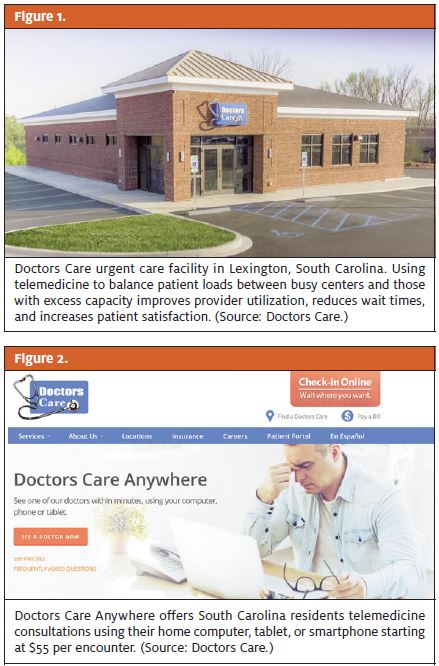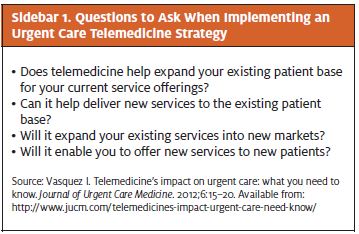Urgent message: Telemedicine can augment walk-in urgent care operations via provider load–balancing across centers in multiunit networks as well as direct-to-consumer platforms that expand a center’s geographic coverage, differentiate a center’s brand from that of competitors, and drive additional revenue.
Introduction
Given that the most common diagnoses seen in urgent care centers are low-acuity, low-touch conditions affecting the respiratory system, ears, nose, or throat—many of which can be treated via telemedicine— the looming question for many urgent care operators is “What will telemedicine’s impact be on my business?”
According to experts, there were 100 million e-visits globally in 2014, up 400% from 2012, with 75% occurring in North America. It is estimated that by 2024, 17% of all provider visits will occur virtually, steering 260 million encounters away from doctors’ offices.[1] Although some common urgent care procedures, such as laceration repair, foreign-body removal, and setting fractures can only be performed in person, many other urgent care visits can be done by telemedicine, which can be cheaper and more convenient for consumers.
Doctors Care, which is based in Columbia, South Carolina, has used telemedicine to stay ahead of the curve, balancing patient loads across its centers since 2014. In 2016, it launched direct-to-consumer telemedicine accessible via home computer, tablet, and smartphone. Load-balancing uses telemedicine to connect a patient who presents at one urgent care center, which may have long wait times due to the ebb and flow in a walk-in medical practice, with a physician at a less-busy center who has excess time available (Figure 1). For insurance purposes, such visits are considered in-office consultations and are reimbursed at the same rate as an office visit. By contrast, direct-to-consumer telemedicine enables a physician encounter via a patient’s electronic device, without the patient traveling to a physical location (Figure 2). Doctors Care currently charges $55 for virtual visits, which may be reimbursed by a health or flexible savings account but are not covered by many insurance plans.
 Doctors Care operates 80 walk-in urgent care, physical therapy, and wellness centers in South Carolina and Tennessee. Doctors Care’s management company, UCI Medical Affiliates, is owned by BlueCross BlueShield of South Carolina. In the following JUCM-exclusive interview, Chief Medical Officer Thomas E. Gibbons explains how telemedicine fits within Doctors Care’s strategy.
Doctors Care operates 80 walk-in urgent care, physical therapy, and wellness centers in South Carolina and Tennessee. Doctors Care’s management company, UCI Medical Affiliates, is owned by BlueCross BlueShield of South Carolina. In the following JUCM-exclusive interview, Chief Medical Officer Thomas E. Gibbons explains how telemedicine fits within Doctors Care’s strategy.
Interview
Alan Ayers: Doctors Care has implemented a couple of different models of telemedicine within and parallel to its urgent care delivery system. Can you differentiate telemedicine used for site-to-site load-balancing, employer/on-site services, and direct-to-consumer?
Thomas Gibbons: Our mission is to provide convenient medical and health care to our customers. To achieve this, we leveraged the applications, quality, and information technology teams on the nonmedical management side of our business, UCI Medical Affiliates, to explore all consumer channels available and develop creative solutions. One result of that effort is a site-to-site load-balancing program we developed in 2014 that allows patients to avoid queues and wait time when they physically walk into one of our 55 urgent care centers. Using this in-office telemedicine program, patients have the choice of waiting for the provider who is physically present in the urgent care center, or of being assisted by a nurse in a connected examination room and undergoing evaluation via telemedicine equipment by one of our staff physicians located in another center or from their homes. We refer to this as “zero wait time.” We can offer this same setup and service to employers.
Our direct-to-consumer service, which we soft-launched in April 2016, simply offers new and existing patients access to one of our employed, trained, and insured physicians directly from DoctorsCare.com using a phone, tablet, or computer. This service is currently available from 8 a.m. to 5 p.m., but we intend to expand those hours over the next few months.
Ayers: What clinical presentations are best suited for telemedicine? How does the technology Doctors Care is using enable physical examination and facilitate diagnosis?
Gibbons: For our direct-to-consumer service from DoctorsCare.com, the most common ailments are runny nose, head congestion, headache, cough, ear pain, nausea/vomiting, diarrhea, skin rashes, sore throat, fever, dizziness, allergies, conjunctivitis, urinary tract infections, and so on. With our site-to-site load-balancing model, the list expands, of course, because the patients physically present in our brick-and-mortar centers—allowing them immediate access to laboratory testing, x-rays, injections, and other services.
Ayers: How does Doctors Care charge for its telemedicine services? What has the response of third-party payors been thus far?
Gibbons: Our in-center load-balancing service is priced low and reimbursed at the same rates as traditional office services. This makes perfect sense to us when considering that our costs are no lower in this model. The major benefit is convenience to our patients. We get very flexible with the model in employers’ work sites and can work out convenient PEPM rates, a flat per-month reimbursement rate, or variations on those themes. Our direct-to-consumer service from DoctorsCare.com is priced at $55 for visits lasting 15 minutes or less.
Ayers: What are the benefits telemedicine brings to urgent care in terms of improved clinical outcomes, increased revenue/profitability, and greater patient satisfaction?
Gibbons: Our driving force was increased patient satisfaction. Doctors Care has 55 centers in South Carolina—so we have a pretty good footprint across the state. This allows us to refer direct-to-consumer telemedicine patients to one of our centers for any necessary laboratory testing or other ancillary care that might be needed. Because our tele-physicians are Doctors Care employees and are physically located in South Carolina, they know the most effective specialist that might be required. This is a huge advantage over some of the national telemedicine players where the tele-physician might have the appropriate in-state licensure but physically resides in, say, California, Texas, or Illinois.
The jury is still out on increased revenue and profitability with telemedicine. Of course, we’re sensitive to avoiding cannibalization of our top-line revenue. The strategy is to actually increase the utility of our services so this becomes a “blue ocean” initiative for us—that is to say, by using telemedicine to offer more options and better convenience without increasing our prices, we provide a better value for our patients [Sidebar 1].
 Ayers: How does telemedicine enhance or contribute to positive patient satisfaction scores, repeat visits, and positive word of mouth?
Ayers: How does telemedicine enhance or contribute to positive patient satisfaction scores, repeat visits, and positive word of mouth?
Gibbons: Doctors Care has been offering telemedicine services since 2014, but we have also implemented a significant number of other patient-centric service initiatives. Accordingly, it is difficult to state that our patient satisfaction scores increased X% because of this single service.
Ayers: Are you concerned that telemedicine could cannibalize conventional low-acuity urgent care cases like sinusitis, upper respiratory infections, or otitis media?
Gibbons: We have worked hard to stay attuned to consumer trends—and to not wake up one morning asking ourselves the question “What just happened?” if we were to suddenly see 30% of our patients slip away. Sure, we might lose some revenue along the way, but we expect to make it up in increased patient traffic and efficiencies with this improved service.
Ayers: What additional insights or learnings can you share related to your telemedicine experience?
Gibbons: Telemedicine may not be for all providers and all organizations, and it may not be to the liking of all patients. We implemented telemedicine services as simply another consumer channel for what we have been offering for 35 years—convenient medical and health care.
Conclusion
Although the impact of telemedicine on urgent care has yet to be determined, progressive urgent care providers are finding ways to integrate the technology. Whether telemedicine is used for load-balancing or to attract new patients, pilot initiatives like those being conducted at Doctors Care will demonstrate the degree to which telemedicine improves throughput, shortens wait times, increases patient satisfaction, and provides additional revenue for existing urgent care operations, thus making a business case to expand the capabilities and reach of telemedicine solutions over time.
[1]SG2 Intelligence. Virtual health: aligning solutions with enterprise-wide priorities [internet]. Skokie, IL: SG2 Intelligence; © 2014 [cited 2016 June 10]. Available from: http://www2.deloitte.com/content/dam/Deloitte/global/Documents/Technology-Media-Telecommunications/gx-tmt-2014predictionevisits.pdf
